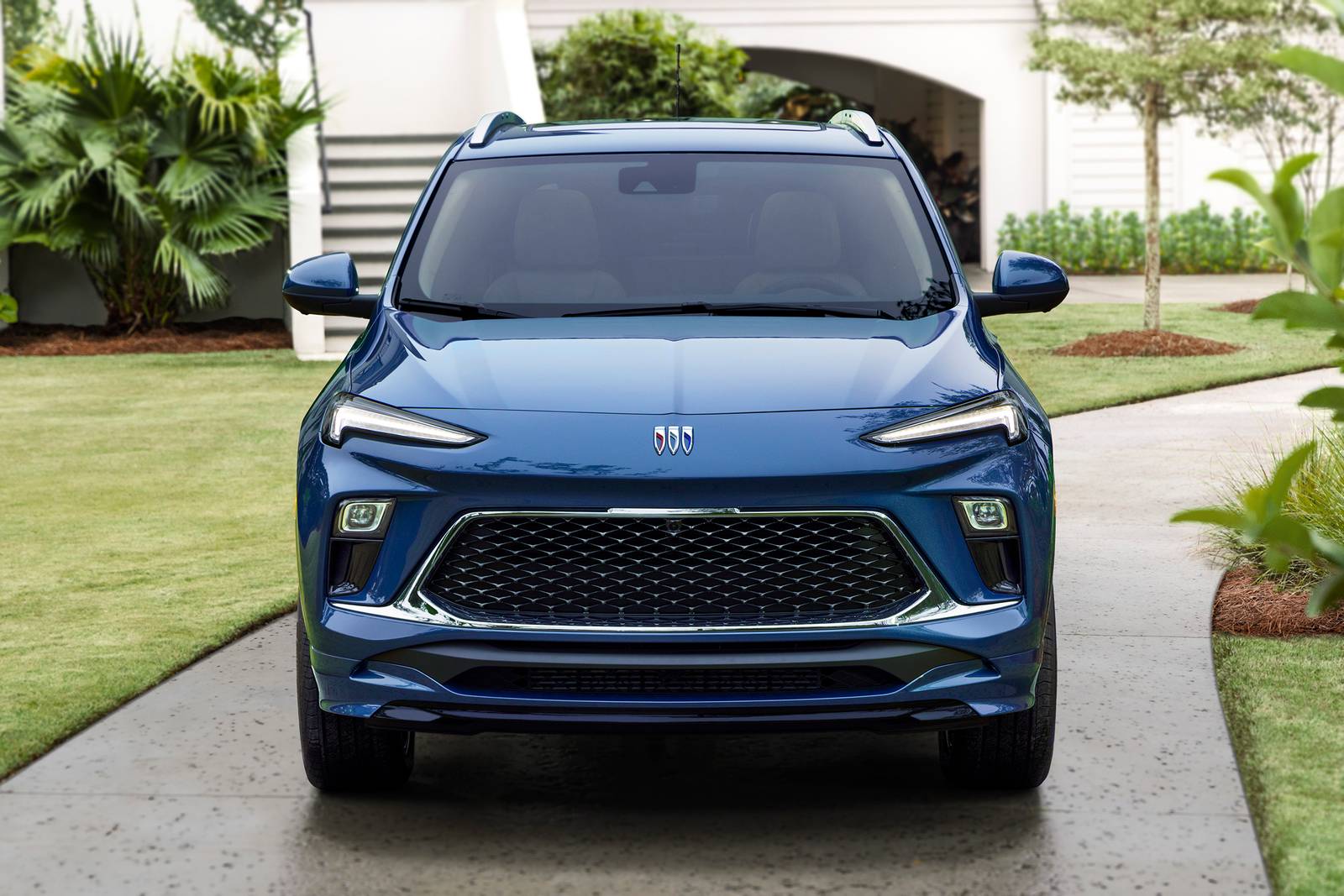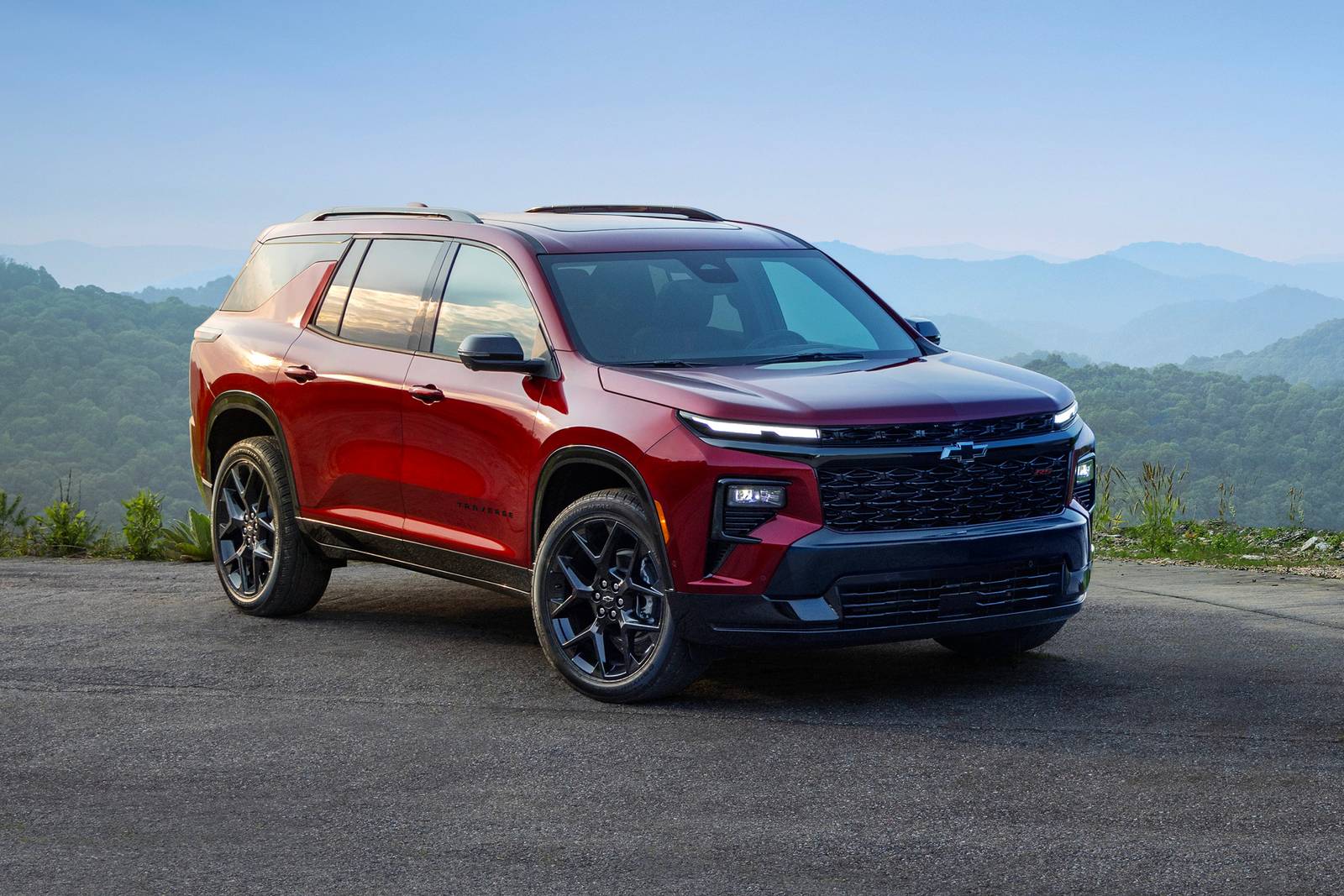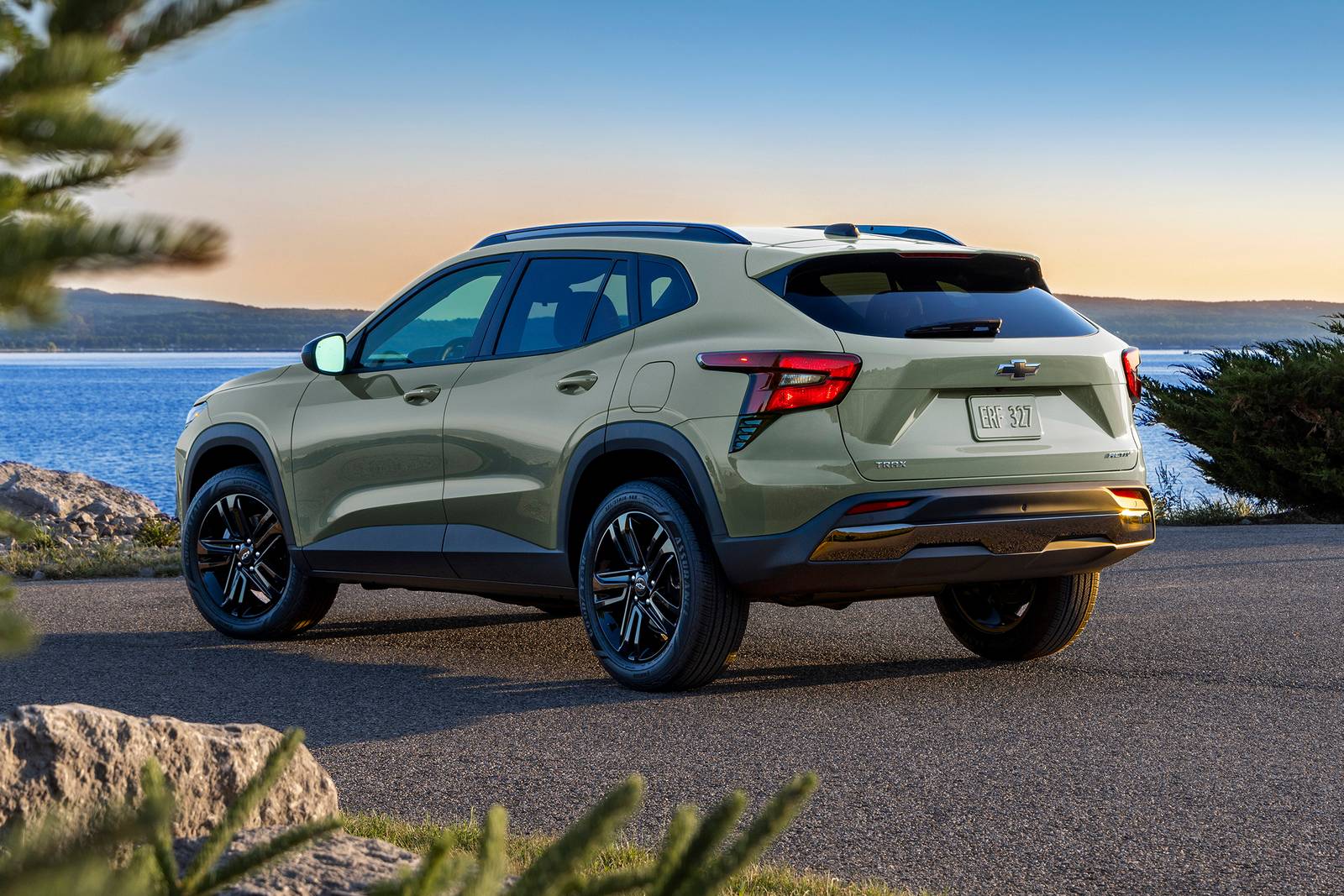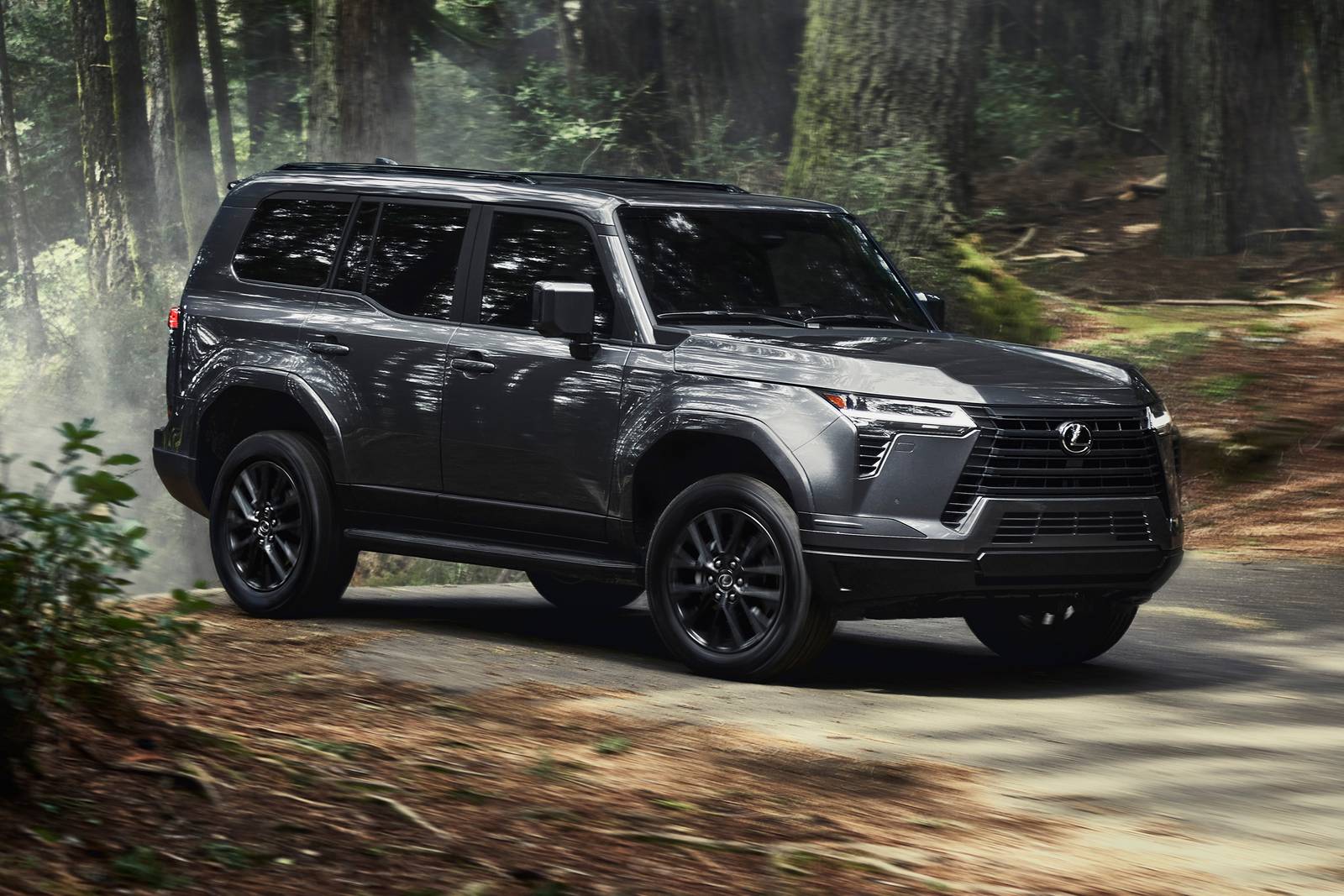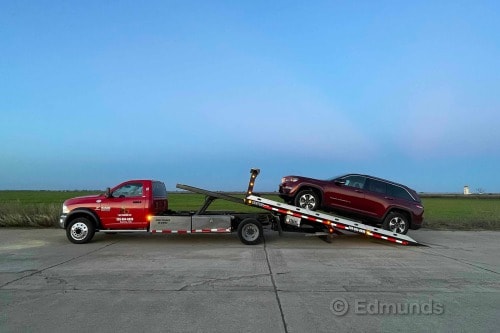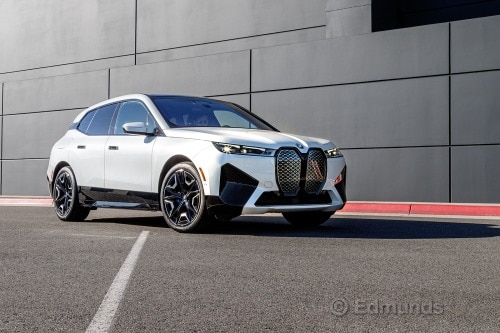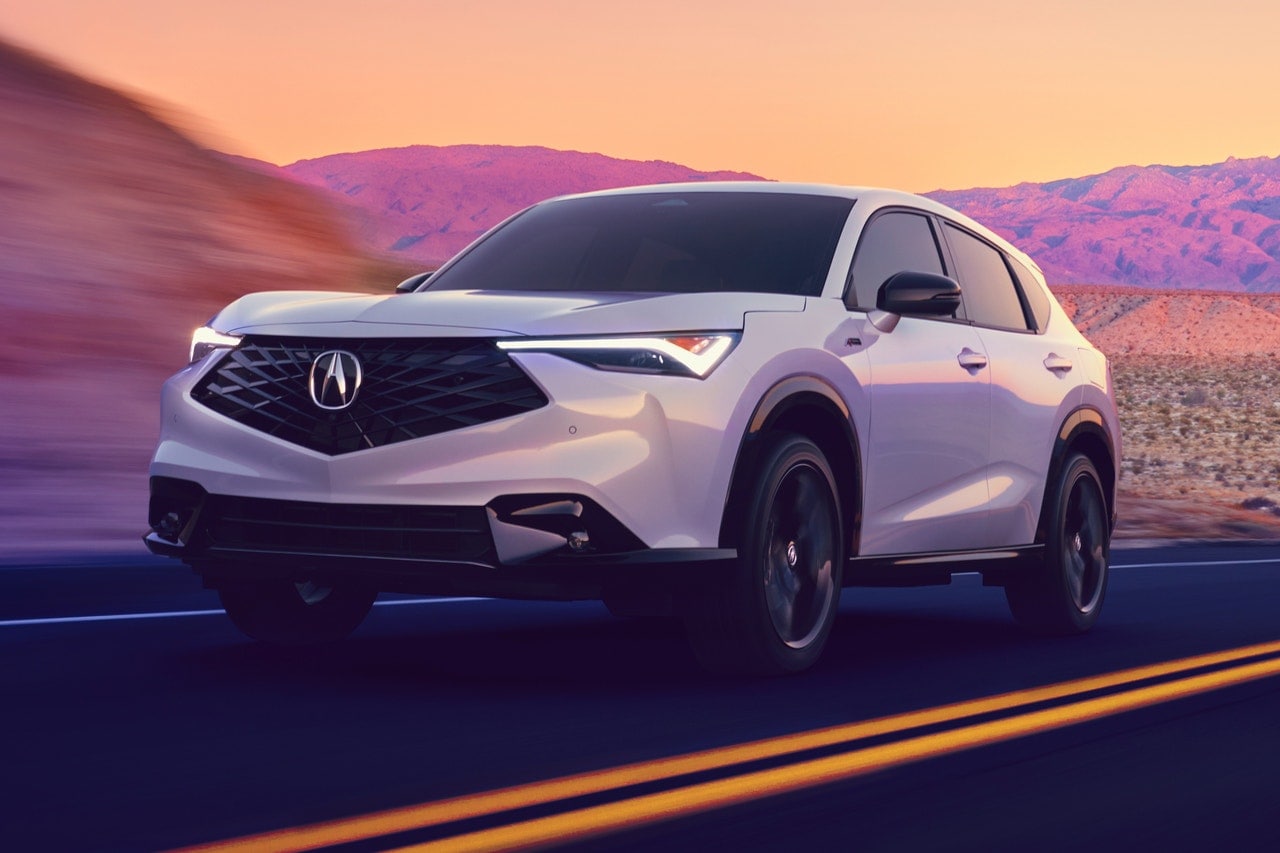Edmunds' SUV Buying Guide
There are so many kinds of SUVs that it's hard to keep them all straight. Let Edmunds be your guide. We'll walk you through all the different kinds of SUVs and help get you to the right place.
Not all SUVs are created equal
Featured by Type
Featured By Price
What’s It Like to Live With?
Edmunds purchases several vehicles each year for the long-term fleet. These vehicles are driven 20,000 miles in the first year of ownership. We report on the red flags, the routine ins and outs, and everything else that car shoppers need to know about the ownership experience.
SUV Videos
Watch Video
The 2025 Acura ADX Is a Sharp New Compact SUV With Honda HR-V Roots | Acura ADX First Look
The 2025 Acura ADX is the brand’s latest SUV, and it’s the smallest one yet.
SUV News
What is an SUV?
Hey, we said the basics, right? So let's start with those three letters: S-U-V. Technically an acronym for sport-utility vehicle, "SUV" refers to a hot-selling automotive type that comes in many sizes, shapes and capabilities. Where SUVs were once little more than trucks with extended cabins, today's SUV fleet includes virtually anything with an elevated ride height and a hatchback-style body. If it's higher than a normal car and it has a wagon-style extended roofline rather than a trunk, it's probably an SUV.
You'll often hear the term "crossover," by the way, but it is simply a marketing term used to describe an SUV based on a car platform rather than a truck platform. We don't consider it an official vehicle type, but it does appear in automakers' advertising campaigns and such — just something to be aware of. What kinds of SUVs are available?
Today, compact and midsize SUVs tend to be the most consistent sellers, although subcompact SUVs have extra appeal for city dwellers. On the other end of the spectrum are buyers who still need that old-school SUV muscle for weekend getaways with a trailer in tow. And then there's the question of whether to spring for a luxury model or stick with one of the mainstream offerings, which are increasingly well equipped. Let Edmunds help guide you to the best fit for your life.
X-Small SUV
At Edmunds we call the smallest SUVs "extra-small," although they're typically referred to as subcompact SUVs in the marketplace. For the most part, these vehicles are just high-riding hatchbacks derived from car platforms, but we don't mean that as a dig. Hatchbacks, after all, are inherently practical, and a higher ride means it's easier to get in and out. Most subcompact SUVs offer adult passenger comfort, although the rear seat can be cramped if the folks in front are on the larger side. The Volkswagen Taos is a solid all-arounder, with a lot of tech and driver aids all wrapped in a spacious package. The same is true of the well-rounded Chevrolet Trailblazer. The Mazda CX-30 looks great and is a blast to drive without sacrificing comfort, while the Hyundai Kona offers spunky turbo power and comes loaded with features for a great price. All-wheel drive comes standard on the Kia Seltos and the Subaru Crosstrek, while the Buick Encore GX excels thanks to its near-luxury interior and driving experience.
Small SUV
Small SUVs, also known as compact SUVs, are the lifeblood of today's SUV market. Nearly every major automaker offers one, and they've largely displaced compact and midsize sedans as the go-to vehicle for small families and commuters alike. Not surprisingly, compact SUVs are where you begin to feel like you're driving an SUV and not a hatchback. Most offer generous cargo capacity and ample room for rear passengers, even with long-legged front occupants. The Mazda CX-50 excels in just about everything from comfort to utility, with the added bonus of standard all-wheel drive. The Subaru Forester also includes standard AWD as well. The Honda CR-V has long been a perennial favorite thanks to its thoughtfully designed interior with huge maximum cargo space. This class is also the domain of the Jeep Wrangler, the preferred choice of serious off-roaders for decades, as well as the revived Ford Bronco that promises to give it a run for its money. For shoppers who prefer sticking to pavement, the Ford Bronco Sport delivers Bronco styling with the road manners of a crossover.
Small 3-Row SUV
If you like the size of compact SUVs but need three rows, there's a handful of compact 3-row SUVs that fit the bill. We admit we're not big fans of the idea, or of the available options. Cramming three rows of seats into a smaller body comes with inherent compromises to passenger comfort. While there are still only a small number of SUVs in this class, the offerings are better than ever before thanks to some updated models. Space is tight in these vehicles, but if you'll only use the third row occasionally, the Kia Sorento includes it as standard, and its attractive and quiet interior stands out in the class. The Volkswagen Tiguan and the Mitsubishi Outlander are also decent picks. The former offers lots of safety and technology features, while the latter offers a comfortable ride and lots of value.
Midsize SUV
Midsize SUVs take the best parts of their compact counterparts and add even more cargo space and more room for passengers to spread out. At this level, you'll also start to see more engine power — sometimes even a V6 engine (most midsizers start with a turbo four-cylinder) — and extra towing strength for small toys and trailers. Many midsizers also offer modest off-road ability, or in some cases (think Ford Bronco, Toyota 4Runner or Jeep Grand Cherokee) exceptional ability. The Honda Passport is tough to top given its comfortable ride, ample interior room and go-anywhere character, while the Volkswagen Atlas Cross Sport pairs rugged good looks with well-executed tech features. The Hyundai Santa Fe is a nice alternative if you get the turbo engine, and the Toyota Venza is the only midsize crossover with a hybrid powertrain. The Hyundai Santa Fe is a nice alternative if you get the turbo engine, and the Toyota Venza and Jeep Grand Cherokee are available with hybrid powertrains.
Midsize 3-Row SUV
Moving up to midsize SUVs with three rows, you're squarely in growing-family territory. These are the SUVs you want when you need to move a few kids and their things, but you can't stomach the thought of a minivan. Most offer a V6 engine or a high-power turbo four-cylinder, loads of room, and comfortable cabins made for long distances. Despite their size, these SUVs are fairly easy to drive in the city due to their car-like underpinnings. Both the Kia Telluride and Hyundai Palisade impress with their spacious cabins, upscale interior appointments, and adult comfort in all three rows. The Honda Pilot, Toyota Highlander and Toyota Grand Highlander compete well across the board, while the Volkswagen Atlas delivers incredible passenger and cargo room. If your off-pavement needs are modest at best, the Mazda CX-9 is arguably the best to drive of this bunch.
Large SUV
This segment is the last stronghold of the traditional SUV that dominated American garages from the 1990s into the 2000s. It's not hard to see the appeal of these brutes, what with their robust towing capabilities and massive interiors that can typically seat seven or eight passengers. On the other hand, large SUVs are relatively cumbersome from behind the wheel, and their interiors are compromised by truck-like platforms that impinge on available space. Keep an eye out for the Chevrolet Tahoe and Chevrolet Suburban siblings, along with their corporate cousins — the GMC Yukon and GMC Yukon XL. Recent redesigns from both Chevy and GMC brought new suspensions and interiors for increased comfort — there's even an optional turbodiesel engine for additional towing capacity and fuel economy. The Ford Expedition rates highly since it can tow more than 9,000 pounds and be optioned up to exaggerated levels of luxury, while the Toyota Sequoia finally got a redesign and competes capably in most areas.
X-Small Luxury SUV
Luxury subcompact SUVs might share the same size as their mainstream counterparts, but at this level, you can expect upgrades that match the elevated prices. That means more sophisticated interior materials and infotainment systems, advanced driver aids, and increased power and performance. There's no shortage of choices in this group, from Lexus to Cadillac to Infiniti. But the Mercedes-Benz GLB makes the most of its size with a spacious cabin, loads of tech and genuinely adventurous performance. You can also consider the Audi Q3 and the Volvo XC40, which are built more for the urban jungle than dusty trails, serving as quiet and comfortable SUVs for small families and empty nesters. The Mercedes-Benz GLA is smaller than the GLB yet is pleasant and accommodating in its own right, while the recently redesigned BMW X1 adds driving excitement to the fold.
Small Luxury SUV
Like their non-luxury brethren, compact luxury SUVs feel more like utility vehicles than hatchbacks. Here you'll find extensive lists of luxury equipment and advanced technology, along with more upscale cabins and higher-horsepower engines. There have been a lot of new entries or updated models in this class. The Genesis GV70 might be one of the newest kids on the block, but it immediately impressed with a premium look and feel at a great value. The Mercedes-Benz GLC has been redesigned, offering smooth power, lots of tech and a comfortable interior. It's also worth checking out the Acura RDX, a relatively affordable compact SUV with sharp handling and a cabin design inspired by the NSX supercar. There are other excellent options in this class including the Volvo XC60 and sporty Porsche Macan.
Midsize Luxury SUV
Midsize luxury SUVs are all about interior refinement, top-shelf technology, and often the option of serious power and handling, if you're into that sort of thing. For peak performance, the European models are a class apart, exemplified by the Mercedes-Benz GLE with its exquisite cabin quality, cutting-edge infotainment system and a range of near-perfect engines. The same can be said of the BMW X5, which also has the distinction of having one of the only plug-in hybrid powertrains in the class. The sporty Porsche Cayenne and Audi Q8 are different takes on this formula from the same automaker (Volkswagen Group), while the return of the Land Rover Defender offers a modern take on the brand's rough and rugged roots. These established models should be on high alert, however, with the tech-laden Genesis GV80 hot on their tails.
Midsize 3-Row Luxury SUV
Like their 2-row counterparts, 3-row midsize luxury SUVs focus on comfort, serenity and tech, although it's harder to find bonkers horsepower numbers in this group. If you're looking for adult-size space in the third row, it's worth noting that you're actually more likely to find it among mainstream 3-row midsizers. Provided you only want the extra seats for occasional use, the newly restyled Audi Q7 merits close consideration thanks to cutting-edge technology and upper-crust refinement on the road. You can turn down the pragmatic path with the Acura MDX, or the opulent one with the Lincoln Aviator. And if you're looking to tackle off-road courses, the Land Rover Discovery is another solid choice.
Large Luxury SUV
Large luxury SUVs are essentially old-school SUVs in a tuxedo. You get the same eight-passenger seating (although most offer optional second-row captain's chairs that reduce capacity to seven), big power and robust towing capacity. But here you'll find exclusive luxury amenities such as high-quality leather upholstery, premium-branded stereo systems, and power seats with seemingly countless adjustments. Some big luxury SUVs also offer extended-length variants, while nearly all deliver bold styling. The Cadillac Escalade and Lincoln Navigator are the leaders when it comes to large luxury SUVs from America, offering well-appointed, spacious interiors with lots of tech, plenty of advanced driver aids, and strong powertrains. The revived Jeep Grand Wagoneer brings back a storied name and a bit of the Jeep flair to the luxury SUV segment. The BMW X7 and Mercedes-Benz GLS can't match the Americans when it comes to space but offer a premium European feel, excellent ride and handling, and standard all-wheel drive.
Super Luxury SUV
This class is almost self-explanatory. It's where luxury and ultra-luxury brands bring their loyal customers when the priorities are extra cargo space and a commanding view of the road. No luxury is too precious. You'll often find leather upholstery softer than you can imagine, exotic wood inlays, crystal accents around the cabin, and bespoke interior color schemes. These SUVs also tend to come with V8 or even 12-cylinder engines, six-figure prices and impressive off-road capabilities. The Bentley Bentayga blends impeccable old-world craftsmanship with absurd thrust and optional seven-passenger seating. On the sportier side are the Lamborghini Urus — which distills the Italian brand's visceral performance and styling into a sharply creased SUV suit — and the Aston Martin DBX — perfect for buyers who want to live out their James Bond fantasies on the way to soccer practice. The BMW Alpina XB7 combines a bit of both luxury and sport and offers a rare third row in this class. But for many people shopping this segment, the blocky Mercedes-Benz G-Class is just too boss to resist.
Electric SUV
Just a few years ago, the electric SUV segment was small enough to be summed up with a single paragraph. That's no longer the case with seemingly every automaker releasing or planning to release an all-electric sport-ute. The small electric SUVs in this segment are defined by their lack of all-wheel drive, but they tend to offer more range and a lower price than some of their larger brethren. And while they don't offer the off-road capability of a regular SUV, the hatch gives them similar utility. The Kia Niro EV was fully redesigned for 2023, improving upon what was already one of the best electric SUVs out thanks to a spacious cabin, good tech and solid real-world range. The related Hyundai Kona EV is slightly smaller but offers even more electric range. The Chevrolet Bolt EUV lacks the polish of some rivals but has a price tag that can't be ignored. It's also worth checking out rear-wheel-drive versions of the Hyundai Ioniq 5, Ford Mustang Mach-E and Kia EV6 if you need a bit more space.
All-Wheel-Drive Electric SUV
Most entry-level electric SUVs don't even offer all-wheel drive, while the vast majority of electric vehicles — car, truck or SUV — are at least available with all-wheel drive as an option. While these SUVs might feature all-wheel drive, it's mainly intended for on-road performance and traction as most electric SUVs lack the ground clearance to perform well on anything but a light trail. That's not really an issue as many EVs in this class are exceedingly good to drive on the street. All-wheel-drive EVs in general also tend to have less range than their two-wheel-drive counterparts, but the trade-off you get with all-wheel drive is dramatically better acceleration. The Hyundai Ioniq 5 and Kia EV6 offer sporty and futuristic styling, comfortable cabins, lots of in-car tech and solid electric range. The Ford Mustang Mach-E brings classic styling, sporty handling and a comfortable cabin to this class.
Luxury Electric SUV
The luxury electric SUV segment is an extremely competitive one, with established automakers fighting tooth and nail against relative upstarts for a slice of the pie. These luxury electric SUVs are generally a little larger than non-luxury ones and feature more premium cabins, more available tech and generally even higher performance. A handful offer three rows of seating, though no electric SUV offers as much passenger space as you'll find in some large gas-powered vehicles. The Tesla Model X and Tesla Model Y are two of the most popular models in this class, offering lots of tech, quick acceleration and access to Tesla's vast Supercharger network. The Rivian R1S is another model from a relatively new automaker, offering genuine off-road capability in addition to luxury appointments and excellent range. Although they weren't first, established luxury automakers have been rolling out their own electric models. The BMW iX is a real killer, packing exceptional real-world range, great performance and an impressive interior. The Mercedes-Benz EQS SUV packs loads of in-car tech and a smooth electric powertrain in a premium, tech-filled package.
Performance Electric SUV
One of the best things about the move to electrification is just how quick cars and SUVs feel. Electric motors supply lots of torque, and you don't have to wait for an engine to rev to deploy it. That makes most electric SUVs feel quick, but not all are created equal. Some automakers have turned up the performance a bit. While these models sacrifice some range compared to their standard brethren, their performance is nearly unparalleled by any SUV, electric or not. The specs sheets on some of these compare favorably to some supercars, and they all have four doors, plenty of cargo space, and standard all-wheel drive. The BMW iX M60 offers truly impressive acceleration and handling in addition to the benefits of the already excellent iX. The Tesla Model Y Performance and Tesla Model X Plaid are quick and sporty and are available with some impressive in-car tech. On the more affordable front, the Genesis GV60 and Kia EV6 GT both feel closer to sporty hot hatches than they do a truck-like SUV.
SUV features checklist
While the volume of available SUVs can be overwhelming, the number of features they all offer is staggering in its own right. When determining the most meaningful features for you, it's useful to review the range of available features across major feature categories. Later on, you can drill down to the really important decisions, like whether you want the sunroof, the hands-free tailgate ... or both!
SUV styling
An SUV's exterior styling is its most subjective quality. Either you're drawn to it or you're not. Some SUVs broadcast rugged capability with reinforced lower panels, chunky tires and elevated ride height. Others are city slickers with elegant lines, dazzling LED accent lights and shiny chrome trim. Form usually follows function here, so be sure to determine how high you'll need to step in and out of the SUV. Also take note of the liftover height into the rear cargo area — that is, how high you have to lift your cargo to get it in. You don't want to end up with an SUV that you love looking at but have trouble using on a daily basis.
SUV performance
Even a small SUV can put a big strain on an engine, and automakers are constantly trying to balance power with fuel economy. That's why you'll often find relatively small turbocharged engines in today's SUVs — the turbo helps generate easy low-end torque, while the smaller size limits fuel consumption. Even SUVs with V8 engines tend to lean on turbocharging for the same reasons. In fact, today's turbo technology is advanced enough that a boosted four-cylinder engine can generate the power necessary to drive a large 3-row SUV. But not all small engines are created equal, so it pays to test-drive a few, particularly in passing situations on the highway. Of course, electric SUVs can take SUV performance to a whole new level.
SUV fuel economy
Today's SUVs are more fuel-efficient than ever, but they're still larger and heavier than their sedan counterparts, and the trade-off for that additional utility comes at the pump. Some smaller SUVs do almost as well on gas as regular cars. But fuel efficiency dwindles as SUVs grow larger, heavier and more muscular, with combined mpg in the teens for the real bruisers. Not surprisingly, the most fuel-efficient SUVs are hybrids, but only a handful of automakers even offer a hybrid SUV. That's changing, but it's worth contemplating whether you really need to hold out for a hybrid SUV when today's gas-powered SUVs are often capable of 25-30 mpg combined. Having said that, hybrid SUVs tend to do much better in congested stop-and-go driving than their conventional rivals. So if you spend a lot of time inching through the city, a hybrid SUV could save you a lot of gas money.
SUV seating
Today's SUVs seat anywhere from five to nine passengers (more exotic high-performance SUVs sometimes offer just four seats). But just because an SUV offers five seat belts doesn't mean you'll have five happy passengers. Many smaller SUVs can really only seat two adults comfortably in the rear seat, and if it's a subcompact SUV, rear legroom could be at a premium. Generally speaking, you'll need a midsize SUV or else an unusually spacious compact SUV if you want to ferry adults or growing teens in comfort.
Moving up to larger truck-based SUVs opens up more elbow room, and in the case of extended-length models, lounge-like levels of legroom. As for 3-row SUVs, they offer widely varying amounts of third-row space. Some third rows are suited for adults, while others are too cramped for all but small children. As always, your best bet is to visit the dealership and try it out for yourself.
SUV cargo space
One of the primary reasons to consider an SUV is for its cargo space, but not all cargo space is created equal. Some SUVs prioritize utility with interiors that make the best use of space and maximize every cubic foot. Others tend to compromise on cargo in favor of more extroverted styling flourishes such as fastback rooflines. Still others sacrifice cargo space for a roomier back seat.
When considering cargo space, cubic footage is not a definitive measurement, although it's a good ballpark figure. You'll also want to see how easy it is to load cargo (is the rear bumper too high?) and how flush the rear seats fold into the floor for maximum space. That said, even some compact and midsize SUVs offer space that rivals a small pickup truck's bed, so there's no shortage of utility if you look in the right places.
SUV infotainment
Automakers often use infotainment systems to distinguish their models from the competition, and SUVs are no different. When other capabilities are so closely matched, sometimes it's the ease — or frustration — of using an infotainment system that gives an SUV an edge with buyers. Here you want to look for 7- or 8-inch touchscreen displays, or even larger; many large luxury SUVs offer 10-plus-inch displays. Nearly all SUVs today offer Apple CarPlay and Android Auto smartphone connectivity, and many offer rear-seat USB charging ports or ports that can both charge and pass data (music files, for example) to the main entertainment system.
Some SUVs still offer rear entertainment systems that typically include an overhead display or dual displays mounted on the back of the front seats. More advanced systems also provide an HDMI input for connecting a separate video source, such as a portable player or tablet.
SUV safety and driver assistance
Many drivers prefer SUVs to sedans because of the elevated height and superior view of the road. But sometimes that's where the SUV's advantage ends. The design and styling of most SUVs mean it's often hard to get a good look to the sides or rear, especially during a lane change or when parking.
Most SUVs today offer a blind-spot monitor (a visual or audible alert when another car is in your blind spot) as standard or at least optional, as well as front and rear parking sensors. Rearview cameras are a godsend in close quarters, especially those with 360-degree or top-down views. Rear cross-traffic alert, which warns when a vehicle is approaching or crossing your reverse path, is also a handy feature to look for and often comes bundled with blind-spot warning. Of course, advanced driving aids such as adaptive cruise control, lane departure prevention and automatic emergency braking are increasingly commonplace, with more exotic safety systems typically found first on luxury models.
SUV off-road equipment
Given their elevated ride heights, most SUVs can go off-road, but only a handful are truly off-road-capable. The average compact SUV can handle a modest dirt trail en route to a trailhead or swimming hole, but only SUVs equipped with all- or four-wheel drive, fortified suspensions, and generous ground clearance can venture into rougher stuff.
Indeed, that go-anywhere adventurous spirit is fundamental to the appeal of classic truck-based SUVs from Toyota, Jeep and Land Rover, to name a few. But today you can find impressive off-road capability even in smaller crossovers from Jeep and Subaru. Note that while most SUVs offer all-wheel drive, these systems are typically designed only for stability on slick pavement, not for serious all-terrain work.
Next steps
With SUVs surpassing the popularity of passenger cars in the United States, it's no wonder the options can bewilder even the savviest car shopper. But a little prep work in determining basic needs — how many passengers you'll usually have, how much cargo you'll typically carry, how much money you want to spend — goes a long way toward narrowing the list of choices.
For more insight, visit www.edmunds.com/suv to see which SUVs fared best in our latest rigorous testing.

